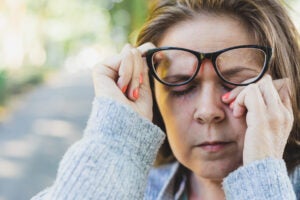Is it Dry Eye, Allergies, or an Infection?

Usually, when an eye doctor encounters a patient with dry eye, eye allergies, or an eye infection, the symptoms are unique enough to make a straightforward diagnosis. However, you may want to know what condition you’re dealing with before visiting the eye doctor. Here’s how to tell the difference between dry eye, allergies, and infections and how to treat each one.
Symptoms
Dry eye can range from mildly annoying to significantly disruptive. You may experience redness, burning, or a feeling that something is in your eye. These symptoms may be accompanied by blurry vision and light sensitivity.
Eye allergies, also known as allergic conjunctivitis, cause itchiness, swelling, and watery eyes. If you rub your eyes continuously, you may experience excessive tear production, redness, and burning.
Eye infections come in many forms, including bacterial and viral conjunctivitis, also known as pink eye. If you have this condition, you may experience eye discharge and crusting of the eyelid, redness, swelling, excessive tear production, itching, burning, and the feeling that something is in your eye.
Causes
Dry eye develops when your eyes don’t produce enough tears. Some cases are related to underlying health conditions, such as rheumatoid arthritis or thyroid disease. Other causes include smoking, dehydration, low humidity, hormone fluctuations, and excessive screen time.
Eye allergies are seasonal for many people, with heightened symptoms occurring during spring and fall. For others, eye allergies occur year-round. The most common allergens include pollen, pet dander, dust mites, mold, smoke, and artificial fragrances.
Eye infections may develop following exposure to certain bacteria and viruses. Conjunctivitis is highly contagious and spreads easily throughout daycare centers, schools, and workplaces. If you suspect you have pink eye, you should avoid touching your eyes and not share items like towels with anyone.
Treatments
Dr. Sarah L. Wood O.D. recommends the following quick fixes for patients experiencing these symptoms or conditions.
Dry eye is treated with special eye drops known as artificial tears. While you can find these over the counter, prescription drops may be required in severe cases. Be aware that allergy drops can make dry eye worse, so it’s important to receive an accurate diagnosis. Fish oil, Omega-3 supplements, as well as a warm compress can have additional benefits on top of using artificial tears.
Eye allergies should improve if you avoid the things you’re allergic to. When this isn’t possible, you can take oral antihistamines to prevent eye allergies and use eye drops when you need instant relief. Artificial tear products can also help rinse allergens out of your eyes.
Eye infections can often be treated at home. Apply a warm compress and apply artificial tears to combat dryness. You should also stop wearing contact lenses until the infection clears. Talk to your doctor about prescription antibiotics if your symptoms don’t improve within two to five days.
No matter what eye condition you think you have, Spindel Eye Associates can provide the diagnosis and treatment you need. Reach out to Dr. Wood or any of our providers if you have questions regarding dry eye, eye allergies, or an eye infection. Our eye specialists have over 35 years of experience treating eye problems and helping our patients enjoy the best vision possible. For more information or to schedule an appointment in Derry, Londonderry, Windham, or Raymond NH, please call 603.421.6536 or contact us online.
RECENT POSTS
categories
- Uncategorized
- Eye Exams
- Lasik
- Spindel Eye Reviews
- Cataracts
- Dry Eyes
- Refractive Errors
- Infographic
- Glaucoma
- Macular Degeneration
- Ocular Diseases
- Pulsed Light Therapy
- IPL
- eye care
- eye health
- Eye irritation
- Eye Syndrome
- Eye Doctors
- Diabetes
- Contacts
- LASIK Surgery
- dry eye syndrome Manchester
- Glasses
- Vision Care
- LipiFlow
- Contact Lenses
- Astigmatism
- Crizal Prevencia
- Spindel Eye
- Children
- skin cancer
